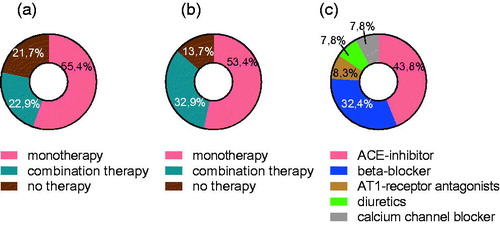Figures & data
Figure 1. Prevalence, incidence and risk distribution of patients with arterial hypertension. (a) Proportion of patients with known and newly diagnosed hypertension (HT) in 2012. (b) Patients with incident hypertension who were known to have one or more cardiovascular comorbidities (stroke, myocardial infarction, heart failure, chronic kidney disease or diabetes) or hypertension-mediated organ damage (HMOD) were classified as risk patients. (c) Percentage of risk patients with one or more HMOD only, cardiovascular comorbidities only, or both.

Figure 2. Therapeutic strategies for patients with newly diagnosed HT. (a) Proportion of patients with initial monotherapy, combination therapy or no therapy (1 year). (b) Proportion of high-risk patients with initial monotherapy, combination therapy or no therapy. (c) Proportion of different antihypertensive drug classes in monotherapy.

Figure 3. HT treatment after one year and long term. (a) Therapeutic strategy one year after diagnosis. (b) Therapeutic strategy one year after diagnosis in patients with initial monotherapy. (c) Therapeutic pattern one year after diagnosis in patients without initial drug therapy. (d) Long-term (>1 year) therapy pattern in patients with pre-existing hypertension.

Data availability statement
The data that support the findings of this study are available from the corresponding author, FP upon reasonable request.
